Coils and slit strip coils with a vertical winding axis
 |
Slit strip coils - fastened onto wooden sleds with steel strapping |
Before loading, attachment to the skids should be checked. If the method of application or condition of the straps gives the impression that they could slacken or be unable of withstanding anticipated acceleration forces, additional attachment to the skids should be ensured.
Depending on their dimensions, coils should where possible be packed without gaps. Any remaining gaps should be filled with lumber members. Lashings may be passed through the eye, but only if the coil is not completely shrink-wrapped. If lashings cannot be passed through the eye, shoring is very effective in preventing slit strip coils from moving.
In some cases, it is entirely possible to secure even slit strip coils with airbags.
Some suggestions and comments on securing are given below. Some may be applied as alternatives, some in combinations while still others should not be used.
 |
|
| Not like this, please: securing of coils/slit strip coils with airbags - plan view |
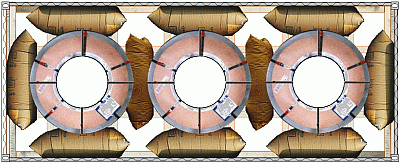 |
|
| Inadmissible use of airbags - plan view |
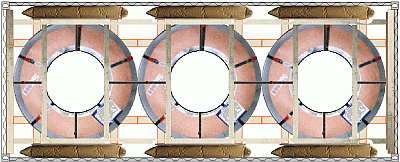 |
|
| Possible: sideways securing with airbags - plan view |
Securing was provided at the front end with a beam lattice and a walking board. A walking board was stood at the side of each coil, the board being braced at the bottom against the sled and at the top against a wooden frame. Each walking board also rests against the outer edge of the coil. The airbags have only a small gap to fill. Bracing with beams is provided in the door area. In the drawing, the upper frames are shown slightly offset to give a better view of the overall securing arrangement. In practice, they should be positioned perpendicularly above the wooden sled members.
This detail drawing clarifies the situation:
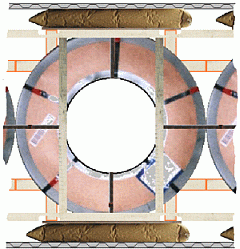 |
Possible: sideways securing with airbags - plan view |
It should be noted, however, that these and the following examples with three coils are not entirely realistic as the coil diameters are very large and they can accordingly only be coils or slit strip coils with a short winding axis, as the masses would otherwise exceed the container payload.
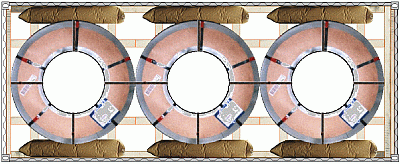 |
|
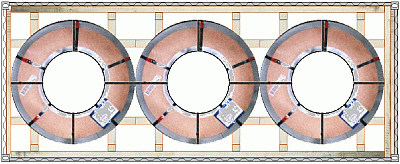 |
|
| Feasible: securing of tightly fastened coils with bracing at floor level, airbags to provide support - plan view |
In this variant, the use of airbags is quite likely. The coils are wide, but flat and not at risk of tipping. The coil is blocked at floor level and towards the ends. Strapping to the skids is sufficiently strong. The airbags are merely intended to relieve the load on the coil strapping on the sleds.
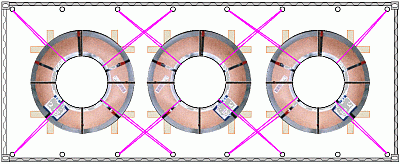 |
|
| Securing of coils/slit strip coils with loop lashings passed through the eye - plan view |
Depending on the mass of the cargo and the maximum securing loads of the lashings, this method may be adequate by itself. With high cargo masses or low maximum securing loads of the lashings, additional measures should be taken.
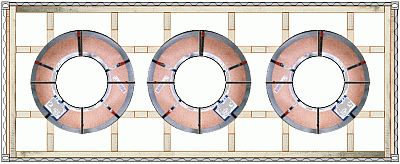 |
|
| Securing coils/slit strip coils with wooden bracing - plan view |
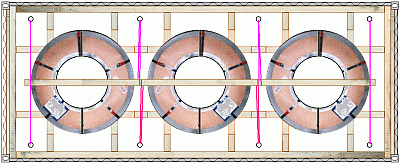 |
|
| Securing with squared lumber and hold-down members |
Skids braced only at floor level could escape the bracing if tipped up. In order to counter this risk, they must additionally be held down. This may be achieved by using squared lumber together with "tie-down lashings" and/or loop lashings. When applied in this manner, "tie-down lashings" act as direct lashings against upward motion. Tie-down lashings cannot be used alone because the lumber used to hold down the cargo could otherwise shift.
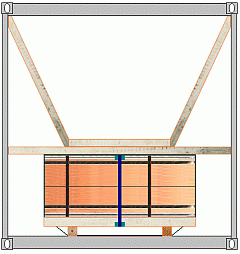 |
Securing of coils/ slit strip coils with shoring - cross-section |
Shoring in conjunction with friction-enhancing materials, may be sufficient if the shoring members are driven strongly apart and so generate large pressure forces. This cannot be done with large masses because admissible line loads would be exceeded.
| Securing with wooden bracing at floor level and shoring - cross-section |
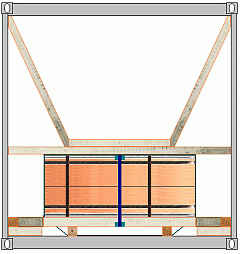 |
If the cargo is secured at floor level by wooden bracing, the shoring members need only be set in place, but not driven strongly apart. It is vital in all cases for the strapping to be able to hold the coils onto the sleds over an extended period.
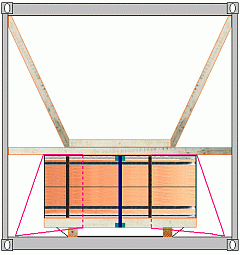 |
Securing with loop lashings through the eye and shoring - plan view |
Passing loop lashings through the eye has the advantage that the load on the strapping is relieved.